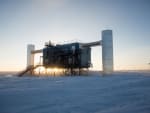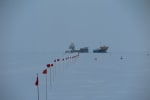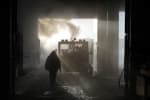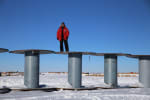The South Pole observatory IceCube has recorded evidence that elusive elementary particles called neutrinos changing their identity as they travel through the Earth and its atmosphere. The observation of these neutrino oscillations, first announced in 1998 by the Super Kamiokande experiment in Japan, opens up new possibilities for particle physics with the Antarctic telescope that was originally designed to detect neutrinos from faraway sources in the cosmos. […]
News
Tidings from the 2015 IceCube Masterclass
The second edition of the IceCube Masterclass took place on Wednesday, March 18, at nine institutions in the US and Europe, and on Saturday, March 14, at the University of Ghent. All in all, 175 high school students analyzed IceCube data in the search for astrophysical neutrinos and cosmic rays. […]
Week 10 at the Pole
Close up, with the sun behind it, or from a distance, with the sun shining upon its face, the ICL, or IceCube Lab, is a rather photogenic building, with its blue, elevated structure and shiny, symmetrical towers. A low, bright sun makes its towers gleam, and the shadows that it casts stretch on and on. […]
Week 9 at the Pole
The temperatures have been dropping, into the –50s °C, while the sun continues to get lower in the sky. These overcast photos give a sense of the impending darkness. […]
Week 8 at the Pole
It was a week of acronyms and snow surveys. Each year at the Pole, before the darkness of winter sets in, IceCube winterovers take advantage of the still available daylight to complete tasks that can’t be managed well in the dark. This week, one of those chores was surveying snow depths from accumulations around the IceTop stations. They got going after they drove an LMC out of the VMF. […]
Searches for time-dependent neutrino sources with IceCube
Searches with IceCube have so far persistently shown us that more data is needed to reveal the first cosmic ray source. But IceCube researchers are convinced that success also requires a resolute determination to exploit IceCube data in every possible manner. In a new study submitted today to the Astrophysical Journal, the collaboration presents a search for time-dependent astrophysical neutrino sources that did not find any evidence for their existence. The study did however make it possible to set upper limits on the neutrino flux from several source candidates and has proven IceCube’s capabilities for long-term monitoring of sources triggered by multiwavelength information from several experiments. […]
Per Olof Hulth (1943-2015)
AMANDA collaborator, first IceCube spokesperson, initiated DeepCore, esteemed colleague and beloved friend. […]
Week 7 at the Pole
What’s the easiest way to get a nicely centered picture of an approaching airplane on the ice at the South Pole? Have it taxi straight toward you. Here’s the last Herc of the season to arrive at the Pole, just as it came to a stop. […]
Week 6 at the Pole
The week began with some extra-nice halos and ended with an exodus of most of the summer people at the Pole. In between, there was typical detector maintenance as well as continued snow management around the IceCube Lab. […]
Week 5 at the Pole
Giant spools sure do serve as a great photo prop. Now empty, these spools had a previous life, brought to the Pole full of cable and ready for action, for use on IceCube and other nearby experiments. But then what to do with them? […]









